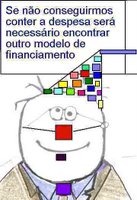Protecção à maternidade

O Decreto-Lei n.º 105/2008 (25.06.08) link veio alargar o período máximo de licença de parto para 120 dias (direito a 100% da remuneração) ou 150 dias (80%).
O mais generoso dos países da EU, no que respeita à protecção social da maternidade, é a Suécia com 390 dias de licença de parto e pagamento de 80% da remuneração base. link
O RU alargou também recentemente o período de dispensa ao trabalho como medida de protecção à maternidade para nove meses mas só com seis semanas de pagamento do salário por inteiro.
O alargamento (desmesurado) do período de ausência ao trabalho (não é o caso de Portugal) até que ponto poderá por em causa a carreira profissional das jovens mães ? Um bom tema de discussão ou mera conjectura reaccionária? link link
O mais generoso dos países da EU, no que respeita à protecção social da maternidade, é a Suécia com 390 dias de licença de parto e pagamento de 80% da remuneração base. link
O RU alargou também recentemente o período de dispensa ao trabalho como medida de protecção à maternidade para nove meses mas só com seis semanas de pagamento do salário por inteiro.
O alargamento (desmesurado) do período de ausência ao trabalho (não é o caso de Portugal) até que ponto poderá por em causa a carreira profissional das jovens mães ? Um bom tema de discussão ou mera conjectura reaccionária? link link
Etiquetas: Politica de Saúde

























8 Comments:
When I was growing up, my parents wanted me to become a doctor, but I had other ideas. I wanted to be a television journalist, or perhaps a trial lawyer or private investigator — something with panache. In college, intoxicated by the mysteries of the universe, I ended up studying condensed-matter physics, in which I eventually earned a Ph.D. But after a close friend contracted an incurable illness, I began to have doubts about my career path. Seeking a profession of tangible purpose — like many older students — I was drawn to medicine.
When I entered medical school at 26, I was considered to be a nontraditional student — but I was hardly alone. A middle-aged woman in my class had an advanced degree in cell biology. One classmate in his early 30s had been a physician assistant for 10 years; there were also a lawyer and an AmeriCorps organizer among us. We were the new face of medicine, or so we were told, and there was considerable interest in us from professors and administrators, if not from our classmates.
The mean age of first-year medical students today is about 24, though 10% are 27 or older. Medical schools now routinely admit students in their 30s or 40s who already have families or are well into another career before turning toward medicine. In general, these students have been welcomed into the profession. They bring maturity, diversity, broader perspectives, "life experience." But what do these physicists, musicians, actors, lawyers, writers, stockbrokers, and dancers add to the profession? Since primary care physicians are in short supply, doesn't medicine just need more conventional, nose-to-the-grindstone clinicians?
Of course, nowadays, when many medical school applicants boast myriad resumé-building experiences, it isn't always clear what "nontraditional" means. Quirky undergraduate concentrations such as music or film are popular among applicants, and so are dual degrees. Female sex ceased to be a distinguishing characteristic years ago. "`Nontraditional' these days is quite a bit different from what it was back when I was in medical school," notes Scott Barnett, associate dean for admissions and graduate medical education at New York's Mount Sinai School of Medicine. "At our school, 50% of medical students are nonscience majors. Out of 140 students, a quarter are from our [undergraduate] Humanities in Medicine program; 10% are M.D.–Ph.D.s; quite a few are career changers."
Such students "are at the forefront of our school," Barnett goes on. "They are older and have a broader view of the world. . . . We've realized that the conventional biology major may not be necessary to produce competent, morally and ethically upstanding citizen-doctors." In Barnett's experience, most people who adopt medicine as a second career "at some point in their lives thought they wanted to be doctors, but their interests led them elsewhere. Maybe the thought of taking a premedical curriculum was repugnant to them. They thought, `I'm going to take full advantage of the 4 years of college; I'll go back and do it later.' They went into teaching, law, finance, the family business, and then, years later, they realize they made a mistake. I think this particularly applies to the finance people — `I'm just making a lot of money, and what am I doing? I'm not helping people.' I think for most nontraditional students, medicine has been scratching at their brains for a long time."
Lawrence Smith, former dean of medical education at New York's Mount Sinai and new dean of the Hofstra University School of Medicine (scheduled to open on Long Island in 2010), says that nontraditional students are often a challenge to medical educators. "They're more self-confident," he says. "They're more conscious of what they want to do with their time. They're less willing to just suck it up and go through the rote aspects of medical training. They are the ones you see in the dean's office saying, `Don't inflict this horrible teacher on me.'
"At the same time, they bring an integrative, adult vision of the world to medicine," Smith adds. "They excel in the clinical setting. They ask smart questions. They challenge assumptions. They ask `why?' more than younger students. They're more comfortable dealing with people. I'm not sure they necessarily make better doctors, but I think the class is definitely enhanced by their presence."
Leslie Kahl, dean of student affairs at Washington University School of Medicine in St. Louis, says that the decision of such students to enter medicine is almost always "self-conscious." "My sense is that they're more focused, more goal-oriented, when they arrive," she says. Kahl agrees with Smith that nontraditional students bring diverse experiences that improve a class. "They help traditional students . . . better envision the opportunities in their future. They influence them to bring a different, maybe slightly more mature or empathetic, approach to their own patients."
By and large, admissions committees seem to agree. Although most medical schools do not keep track of how many nontraditional students they admit, the number has almost certainly increased over the past decade and will probably continue to rise in the face of concerns about a looming doctor shortage.
It is apparent in online discussions hosted by the Web site studentdoctor.net that many nontraditional medical students themselves believe they have advantages over their younger counterparts — greater sensitivity in interactions with patients, more certainty about their career choices, a greater ability to deal with emotional distress, and a clearer sense of what they want to do within medicine.
A 46-year-old intern at my hospital, whom I'll call David Burns, went to medical school in his mid-20s, but when he had a health crisis, he decided to forgo residency and become a teacher. He eventually became a top-level administrator in a large hospital system in Philadelphia, with a six-figure salary and six secretaries. Then, he says, "I hit the big 45 and asked myself, `What is this?' I had always wanted to do medicine." So he started doing daily rounds at 6 a.m. with an ICU team at one of the hospitals he was overseeing. "I loved being there," he recalls. "I wanted to be taking care of people.
"For most interns, this is the first job they've ever had," Burns points out. "They have no concept of being a professional. When you're an older student, you have a different perspective. You spend less time whining that the world is unfair." He plans to apply for a fellowship in critical care — though he realizes that he'll be 51 years old when he finishes his training.
Johnny Lops, a 29-year-old psychiatry resident at my hospital, is a different kind of nontraditional doctor. He was an actor before going to medical school, performing off-Broadway and in television commercials, and he continues to act part-time. "I get to do what I love — psychiatry and acting," he says. "I come to work happy, and because I am happy, I can be a better doctor. So many residents are frustrated. I tell them you need a creative outlet."
Moreover, Lops believes his acting background helps him in medicine. "I definitely know how to handle people and situations more easily," he says. "I'm good at improvisation, so I'm quick on my feet. I have a trained eye and ear, so I'm good with families and their politics."
But more generally, are the diverse backgrounds and interests of nontraditional medical students really what the profession needs? Today, most experts believe that medicine needs more doctors who are able and willing to do the difficult work of primary care, especially since shortages of front-line physicians are expected at the same time as the baby boomers begin reaching Medicare age. Diversity of the workforce is an admirable goal, but it brings challenges, too.
For example, the influx of women into medicine in recent decades has been associated with a change in work habits: today, both male and female doctors are less likely than their predecessors to practice medicine to the exclusion of everything else. A recent survey found that 24% of female physicians under 50 work part-time.1 This trend has put pressure on older doctors nearing retirement, many of whom bemoan the lack of suitable candidates to take over their practices. Is it responsible for medical schools to admit older students who may pursue disparate interests and will probably have shorter career spans? And given that Medicare funds much of graduate medical education in this country, shouldn't the government's investment take the population's needs into consideration?
The disadvantages of older age are often glossed over in discussions about nontraditional students. Medical training requires an intensity of commitment and energy that is almost unique among professions. Older students may not have the same kind of reserves to draw on as their younger, more narrowly focused counterparts. Their greater life experience may make it harder for them to conform to the hospital pecking order, among other adjustments.
When I began medical school, I discovered that the determination and focus of traditional medical students, which had seemed alien to me in college, were well adapted for a career in medicine. Such students could study longer and harder than others, unencumbered as they were by outside responsibilities — or a long hiatus between college and medical school. On the wards, they appeared single-minded and were often able to act quickly, almost reflexively. These strengths have undoubtedly proved advantageous to them as clinicians.
Barnett of Mount Sinai acknowledges that the age and inclination of older students must be factored into admissions decisions. "I think it is in people's minds when they interview students: Will admitting this person, who may be taking the spot of a younger student, produce benefit to society?" he says. "I don't know of a cutoff, but maybe around age 50 you start to wonder if this is just an intellectual exercise.
"We're willing for older applicants to make a case of what they want to do for society," he goes on. "If they can't make a compelling case, then the application is not going to fly. But the same applies to the 21-year-old applicant."
Hofstra's Smith says: "This is . . . obviously a societal question. Does individual freedom take precedence over group needs? In some cases, committees may not think admitting an older student is a good use of the limited number of spots. But you have to be afraid of too much social engineering. Look at women physicians: they tend to work less than men. Does that mean we shouldn't be admitting female students?"
For now, medical school admissions committees continue to accept older, nontraditional students. Perhaps they believe that medicine needs new voices — and given the myriad problems of health care, it is hard to disagree. Nevertheless, I think we need more data before we can call this a viable strategy for the future.
NEJM 17.07.08
A política de acesso ao curso de Medicina das nossas faculdades quantas vocações desviou.
O bastonário da OM continua a insistir no não alargamento das quotas em defesa dos interesses da corporação.
E o que tem um longo texto em inglês a ver com a baixa por maternidade?
Caro tambemquero:
Penso que foi ao encontro do pior exemplo possível relatado pelo NEMJ.
O RU com o seu tradicional sistema de colégios, todo poderosos é, na UE, um excepção.
Quando pretendo explicar o que é um automóvel não vou desmanchar um "Trabant". Nem um Rolls-Royce. É melhor arranjar um veículo de gama média.
Se quiser conhecer corporativismo mesmo a sério vá lá ver.
Nas reuniões da UEMS (União Europeia de Medicos Especialistas) os médicos ingleses não permitem qualquer avanço.
Tomemos por exemplo a Dermatologia. Contnua dividida em Dermatologia e Venereologia, coisa que há dezenas de anos acabou em toda a Europa.
A triagem na entrada na especialidade é tão" apertada" que todo o Reino Unido tem qmenos de dobro de dermatologistas que Portugal.
A Inglaterra, per si, tem cerca de metade...
Dizia o autor Carl Sagan:
"A ausência de evidência não significa evidência de ausência".
Cuidado! não aplicar esta máxima aos novos medicamentos!
Correcção:
O artigo é americano e, não sei porquê, transportei-o para UK.
De qualquer maneira, a realidade europeia é-nos mais próxima e mais premente nestas questões.
Mas não deixa de ser uma lamentável confusão.
Finalmente, o artigo diz respeito a um grupo "especial" de estudantes:
"From All Walks of Life — Nontraditional Medical Students and the Future of Medicine".
E, no amago da questão, vem equacionar um assunto mais vasto, i.e., os mecanismos de acesso (ou de rejeição) ao Ensino Superior e as opções individuais...
Acho um tema tão importante que lhe dediquei um post, há uns tempos atrás (http://defenderoquadrado.blogs.sapo.pt/352691.html).
Cara Sofia:
Hoje, dadas a particular situação demográfica (que apesar das polémicas julgo haver em Portugal um "índice de fecundidade" baixo) a maternidade é, para a gestante, e para a sociedade, um investimento múltiplo.
1. pessoal;
2. familiar;
3. no futuro.
É justo que lhe sejam salvaguardadas, em plenitude, todas as condições laborais, nomeadamente, em relação à progressão na carreira, classificações ou nos escalões (nas situações residuais onde ainda existem…)
A classificação, p. exº. na recente reforma da Administração Pública, deve ser obrigatoriamente de “excelente” (quer haja ou não verba disponível). Conhecem melhor trabalho do que trazer ao Mundo um ser humano?
No regresso ao trabalho efectivo (o lactente e o infante dão muitos trabalhos) e nos casos necessários, devem-lhe ser facultadas todas as condições de horário e inclusive bolsas para efectuar reciclagens que permitam que a maternidade não penalize o casal (ambos os progenitores).
Armando Vara quando andou no governo a fazer "fundações" na Seg. Rodoviária, não foi subindo na carreira de funcionário da CGD?
Se foi assim para o amigo e companheiro de Sócrates, por maioria de razão, deve ser para os casais férteis.
Não é?
Estou de acordo com o apoio à maternidade e à paternidade, desde que se salvaguarde o direito de quem não quer abdicar da sua vida profissional para ser mãe ou pai e desde que se salvaguarde o direito de quem não quer ter filhos.
Na nossa sociedade o aumento em meses do tempo de licença de maternidade tem resultado num maior tempo de ausência da mulher do mercado de trabalho, quando o tem, com as respectivas consequências na progressão da carreira. Para os empregadores é mais um motivo para preterirem as mulheres aos homens. É desse perigo que falo e da subreptícia noção de que é à mulher que compete acompanhar as crianças e que as mulheres preferem naturalmente estar em casa com as crianças do que terem um trabalho fora de casa.
Cara Sofia:
A crise do mercado de trabalho atinge todo o Mundo:
"La France métropolitaine comptait en 2006 7,9 millions de pauvres, soit 13,2% de la population, avec un niveau de vie était inférieur à 880 euros par mois, contre un revenu médian de 1.470 euros par mois (17.600 euros par an)." - LIBERATION : vendredi 18 juillet 2008.
Isto é, a pobreza em França atinge cerca de 80% dos portugueses. Contudo, com um salário médio de 880 euros, deixavamos de ter "pobres" ou baixavamos o indice de pobreza drasticamente.
Assimetrias do desenvolvimento.
A pobreza, que como se depreende, é relativa, incide com maior intensidade no sexo feminino.
Todavia há uma verdade insofismável:
- a relação directa entre a maternidade profícua, produtiva e a pobreza.
Conhecemos, há reativamente poucos anos, esta terrível realidade no nosso País.
Na verdade, a maternidade envolve um Mundo complexo: trabalho, a sexualidade, a afectividade, e as relações familiares.
É um assunto em aberto, nomeadamente, quanto à sua protecção e deverá integrar os programas laborais e de saúde futuros.
Enviar um comentário
<< Home